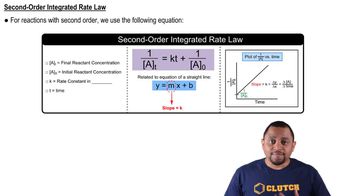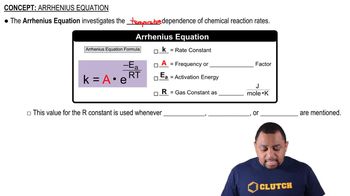Here are the essential concepts you must grasp in order to answer the question correctly.
Second-Order Reactions
Second-order reactions are chemical reactions where the rate is proportional to the square of the concentration of one reactant or the product of the concentrations of two reactants. In this case, the reaction between Cl(g) and H2(g) is second-order, meaning that the rate constant (k) will depend on the concentrations of both reactants. Understanding this concept is crucial for analyzing the rate data provided.
Recommended video:
Arrhenius Equation
The Arrhenius equation relates the rate constant of a reaction to the temperature and activation energy. It is expressed as k = A * e^(-Ea/RT), where k is the rate constant, A is the frequency factor, Ea is the activation energy, R is the universal gas constant, and T is the temperature in Kelvin. This equation is fundamental for determining the activation barrier and frequency factor from the provided rate constants at different temperatures.
Recommended video:
Activation Energy
Activation energy (Ea) is the minimum energy required for a chemical reaction to occur. It represents the energy barrier that reactants must overcome to form products. In the context of the Arrhenius plot, a linear relationship between ln(k) and 1/T allows for the determination of Ea from the slope of the line, which is essential for understanding the kinetics of the given reaction.
Recommended video:




